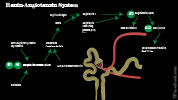II. Physiology: Overall Process
- Images
- Step 1: Renin release
- Stimulators of renin release
- Kidney detects decreased effective Blood Flow
- Increased sympathetic tone
- Renal Artery Stenosis
- Renin secreted from renal cortex
- Secreted from juxtaglomerular cells
- Cells located at afferent arteriole of glomerulus
- Stimulators of renin release
- Step 2: Renin mediated step
- Renin cleaves Angiotensinogen to Angiotensin I
- Step 3: Angiotensin-converting enzyme (ACE) mediated
- Angiotensin I converted by ACE to Angiotensin II
- Conversion by ACE occurs in pulmonary vasculature
- Step 4: Angiotensin II Effects
- Sodium and water retention
- Stimulates Aldosterone secretion
- Directly affects renal tubule
- Vasomotor tone balance
- Angiotensin II is a potent Vasoconstrictor
- Increases systemic vascular resistence
- May be Norepinephrine mediated
- Antagonist to nitric oxide (potent vasodilator)
- Angiotensin II is a potent Vasoconstrictor
- Sodium and water retention
III. Physiology: Angiotensin II
- Angiotensin II Effects
- Increases oxygen demand
- Increases coronary and renal Vasoconstriction
- Increases Preload and Afterload
- Predisposes to Left Ventricular Hypertrophy
- Increases Catecholamine release (e.g. Norepinephrine)
- Increases Aldosterone
- Agents that decrease Angiotensin II levels
IV. References
- Rose (1987) Pathophysiology of Renal Disease, p. 474-7
- Bicket (2002) Am Fam Physician 66(3):461-8 [PubMed]

